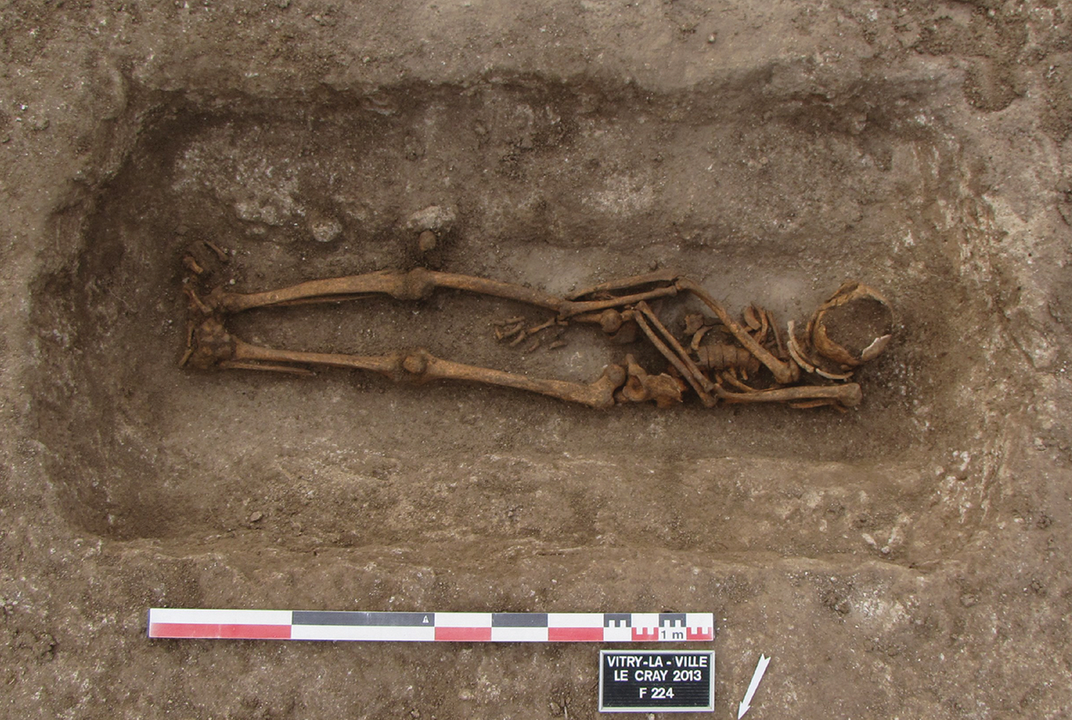Why Did Early Medieval Europeans Reopen Graves?
Contrary to some assumptions, the removal of objects from burial sites was not typically motivated by greed
/https://tf-cmsv2-smithsonianmag-media.s3.amazonaws.com/filer/b6/14/b614a61f-0009-4cdc-a330-8f74a5f82cb9/chamber_grave-france.png)
During the fifth through seventh centuries A.D., people across Europe regularly reopened graves to remove objects buried within. Archaeologists have often classified this act as grave robbing, but as the Jerusalem Post reports, new research suggests that definition isn’t quite right.
The study, published in the journal Antiquity, finds that items removed from burials typically fell under set categories. Often, these artifacts were not the most valuable grave goods present.
“They made a careful selection of possessions to remove, especially taking brooches from women and swords from men, but they left behind lots of valuables, even precious metal objects, including necklace pendants of gold or silver,” says the study’s lead author, Alison Klevnäs, an archaeologist at Stockholm University, in a statement.
The findings suggest that the motivations behind the practice were not greed or shortages of precious metals, as some had previously assumed. In fact, many removed items, such as old swords, were in such poor condition that they wouldn’t have been of any practical use. Still, write the authors, “burial reopening was a common part of the life course of early medieval cemeteries.”
Jack Guy of CNN reports that the new paper combines research conducted by five archaeologists in different places, covering more than 1,000 reopened graves in dozens of cemeteries spanning Transylvania to England. The scholars found that the practice of reopening graves spread across Western Europe in the late sixth century and peaked in the seventh. By the late seventh century, its popularity had begun to decline, with most graves no longer showing signs of having been reopened.
Per Owen Jarus of Live Science, researchers are unsure why people took items from the graves. Their reasoning may have varied depending on the time and place.
“[M]otivations were probably driven as much by local concerns as by broadly shared understandings of death and its rites,” explain the researchers in the paper.

For the most part, people opened the graves within a generation of their original burial, typically after the bodies’ soft tissue had decayed but before wooden coffins collapsed or filled with sediment. Klevnäs tells Live Science that the choice of swords and brooches as the objects most frequently removed suggests that the people who removed them were close to the deceased.
“These were given as gifts and passed on as heirlooms; they’re objects used to link people, including across generations,” she says. “They bring stories and memories. So it’s likely that they are retrieved for these reasons.”
Klevnäs tells CNN that people disturbed the bodies in some of the graves. Often, she adds, they treated them “with complete carelessness.”
In a small number of cases, the deceased’s feet were removed, or their skulls were twisted around, suggesting a fear that the dead might walk again. In one “very unusual example,” says Klevnäs, a dog was placed in a grave, probably in an effort to please the person buried there.
Speaking with New Scientist’s Michael Marshall, Klevnäs points out that the assumption that graves should remain undisturbed is not universal. Today, people in many places revisit loved ones’ remains during rituals or festival events. In the late Stone Age, some graves were designed so that people could return to the bodies. As Brooks Hays reported for United Press International (UPI) last year, after a body decomposed in Neolithic Israel, the grave would be reopened and the skull reburied in a different grave with other people.
Emma Brownlee, an archaeologist at Cambridge University who was not involved in the study, tells Live Science that the new research has implications for scholars’ understanding of cultural connections across early medieval Europe.
“One of the things that strikes me is the fact that reopening is happening in a very similar way in places as far apart as Kent [in England] and Transylvania, suggesting that there was a shared understanding of how to interact with the dead that transcended other cultural boundaries,” she says. “We're only just starting to appreciate how interconnected the early medieval world was, and research like this is enormously helpful.”
/https://tf-cmsv2-smithsonianmag-media.s3.amazonaws.com/accounts/headshot/Livia_lg_thumbnail.png)
/https://tf-cmsv2-smithsonianmag-media.s3.amazonaws.com/accounts/headshot/Livia_lg_thumbnail.png)